Hycean worlds have hydrogen-rich atmospheres and are covered in oceans, making them prime candidates for the search for life outside our own solar system. These worlds are also more numerous and easier to find than Earth-like exoplanets. Plus, an update on the search for Planet 9 and how volcanoes may provide a climate safety valve.
Podcast
Transcript
Hello and welcome to the Daily Space. I am your host Beth Johnson, and I am here to put science in your brain.
Today, we have a roundup of the weird and the wonderful, and it all starts with a tiny asteroid orbiting our Sun at a breakneck pace that requires relativistic orbital calculations.
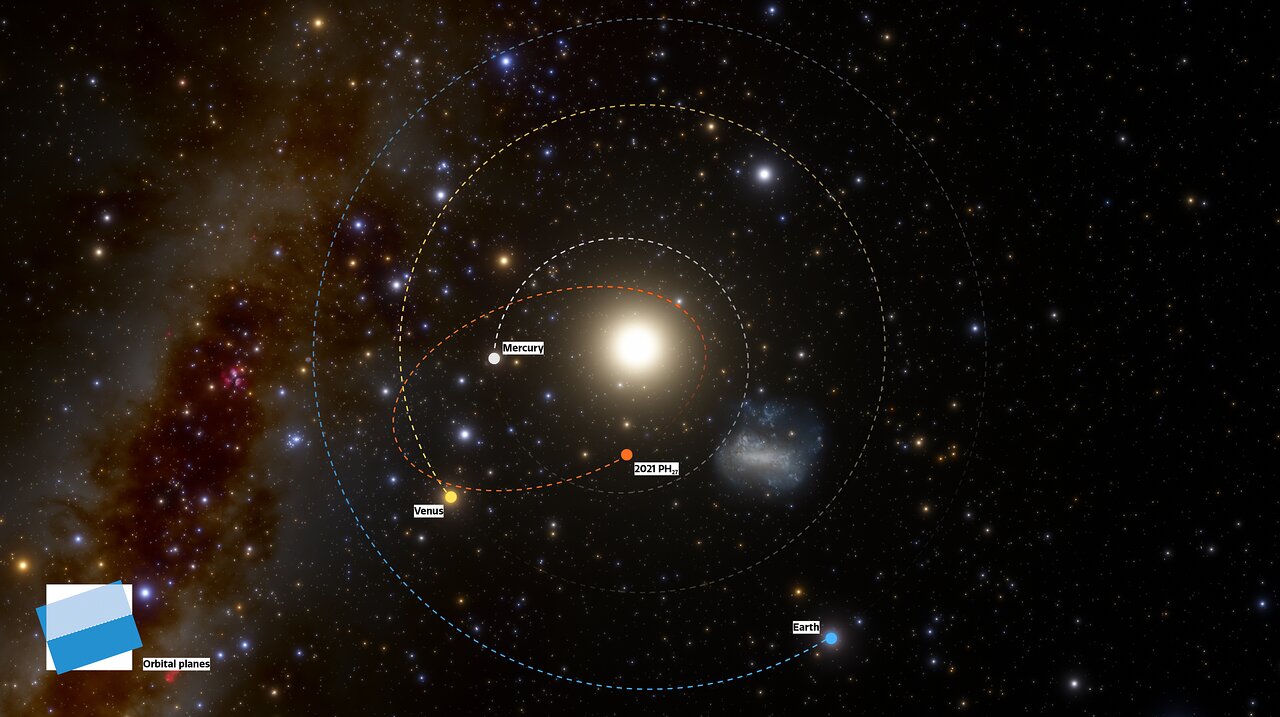
Designated 2021PH27, this kilometer-across asteroid dives within 20 million kilometers of the Sun every 113 days, before zipping back out beyond the orbit of Venus. This new object was discovered by Scott Sheppard using survey data from a survey of local galaxies, showing once again that one person’s interrupting asteroid is another person’s super cool data.
Sheppard is a frequent discoverer of moons, comets, and other small objects throughout the solar system and has built a career on looking for moving objects in data often taken for other purposes. Telescope time is expensive, and it’s awesome to see results from folks like Sheppard who repurpose and recycle data for additional science. This is your friendly reminder that astronomers will stretch their research dollars farther than anyone ever imagined.
Survey data is often perfect for data mining, and many telescopes will spend years taking repeated measurements of large segments of the sky as they peer deep into the universe looking for both known and unknown objects. The Very Large Array in New Mexico, for instance, is currently working on a sky survey, VLASS, that revealed a previously only theoretical event: a small black hole or a neutron star dove into its companion star.
According to co-author Gregg Hallinan: Of all the things we thought we would discover with VLASS, this was not one of them.
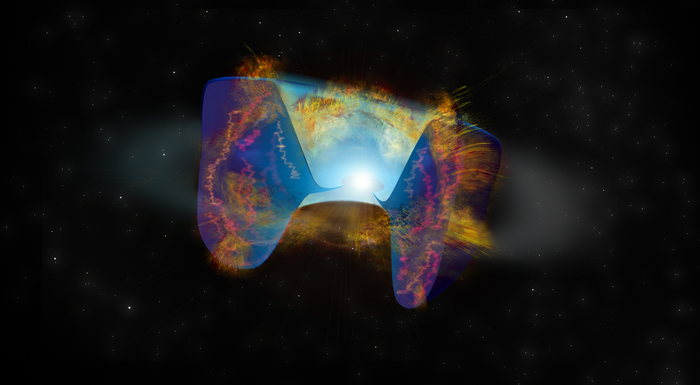
This work appears in Science and was led by Dillon Dong.
This event was discovered as a bright radio source that hadn’t been apparent in earlier surveys. Follow-up observations with the Keck telescope determined the bright source was in the outskirts of a dwarf, star-forming galaxy 480 million light-years from Earth. While trying to sort out when this bright source originated, researchers discovered an X-ray burst was detected from this object’s direction back in 2014. Putting together all this information, they were able to build a fascinating story of just what is going on.
About 300 years ago, it appears that a black hole or neutron star entered the atmosphere of its companion. This caused the star to stream material into its surroundings, and that material forms an expanding ring around the now murdered star. As the black hole or neutron star spiraled toward its companion’s core, it gathered up the surrounding material, and in 2014, it disrupted that vulnerable star’s fusion-powered core. And what used to be a star and a parasitic compact invader exploded as a supernova.
Now before you ask “how do we know what something 480 million light-years away did 300 years ago”, I just want to clarify that when astronomers say “300 years ago” they mean “in the light arriving at Earth, we would have seen this thing that happened 300 years ago”. I don’t write the rules, folks; I just report the news.
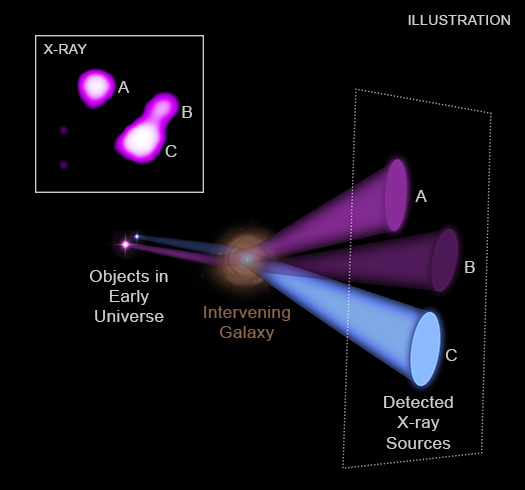
Not everything can be easily found in surveys. Sometimes targeted imaging is needed, and sometimes we need a boost from gravity. Massive galaxies and galaxy clusters can bend light with their gravity, and when that light is bent in our direction, gravity works like a magnifying glass focusing sunlight and allows us to get far more light than might otherwise hit Earth. Like a funhouse mirror, this gravity sometimes warps things along the way, and in some cases, light from a single object can appear as multiple versions of the same object repeated and distorted in the sky.
In observations of complex X-ray sources, researchers discovered that one triple source, MG B2016-112, is likely a pair of distance growing supermassive black holes or maybe one supermassive black hole and jets. And thanks to the speed of light, we’re seeing light that was emitted when the universe was just two billion years old. It is hoped that further observations of this system will allow researchers to understand how supermassive black holes formed in the early universe. This work appears in The Astrophysical Journal and is led by Daniel Schwartz.
The galaxies and galaxy clusters that act like giant magnifying glasses are called gravitational lenses, and how they reshape distant objects is a function of how their mass is distributed and how they are aligned with the background system. These natural lenses were predicted by Albert Einstein, who theorized that in just the right circumstances, an object could be twisted into a ring.
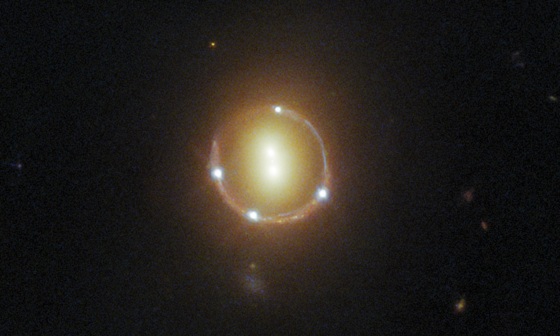
In a newly released Hubble image, this kind of Einstein ring appears to be decorated with four gems. In the center are two massive galaxies whose combined gravity distorts a single background galaxy into a ring and four bright spots. Hundreds of Einstein rings have been discovered, but we here at Daily Space have labeled this the cutest Einstein Ring of all.
Finally, we have a happy update from Mars: the Perseverance rover has successfully sampled a regular rock! Its earlier failure is looking like a fluke of the rock just being too soft and crumbly to work with the sample tools. We also feel the need to point out that the rock they sampled now looks rather like a smiling whale head. Who said scientists don’t have a sense of humor?
When it comes to scientists having a sense of humor, Caltech astrophysicist Mike Brown is one of the best, in my opinion. He is, after all, part of the team that discovered the dwarf planet Eris, so named for the goddess of strife and discord in part because of the controversy over what exactly defined a planet. That controversy led the International Astronomical Union to revise their planetary definition in 2006 and demoted Pluto to a dwarf planet as well. Dr. Brown then began using the Twitter handle plutokiller once the social media service was up and running, and his book is titled How I Killed Pluto and Why It Had It Coming.
Of course, debates about the status of Pluto still rage on the internet and among astronomers and planetary scientists. But that’s not the point of this particular story.
Just when you think Mike Brown couldn’t mess with our solar system any more than he already has, he and fellow astrophysicist Konstantin Batygin proposed back in 2016 that there might be a huge, undiscovered planet out in our solar system. The so-called Planet 9 (sorry, Pluto) is calculated to be about five times the size of Earth and ten times farther away from the Sun than Neptune. They based this hypothesis on the distribution of Kuiper Belt Objects (KBOs) and their orbits.
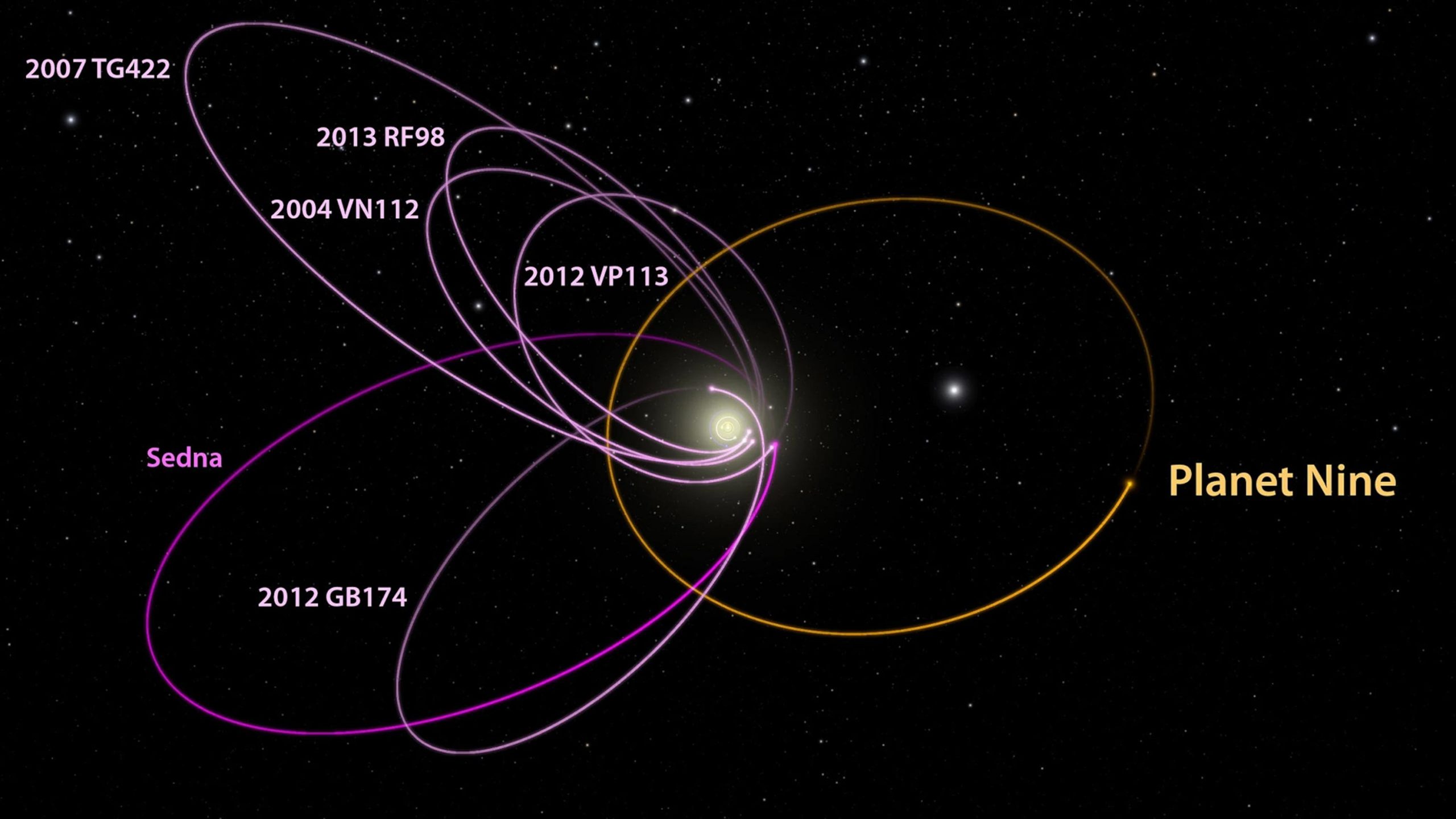
There is an odd clustering of these KBOs that should not happen if there isn’t another, larger body out there influencing their orbits. And those orbits should be randomly oriented with respect to the orbital plane of our solar system as well, but that’s not what we see, either. These two anomalies are what led to the calculations of the size and distance for Planet 9.
Basically, Planet 9, if it exists, is gravitationally pulling on these KBOs and has, over time, shifted their orbits into the clustering seen in the data. From the gravitational pull, you can calculate backward to the orbit of Planet 9. In fact, this is how Neptune was discovered; astronomers noted that Uranus was being pulled on by some unseen celestial body, they did some math, and voila, they found Neptune. So it’s not the first time our understanding of the solar system has shifted, too.
In that 2016 paper, Brown and Batygin even calculated where in the sky the planet might be found. And yet, nothing has come of the search for Planet 9… so far. Plus, there has been quite a bit of criticism of the original paper and its hypothesis, pointing out that the clustering of the KBOs may be due to observational biases. After all, we take telescope time when we can get it and we look where it’s convenient and possible.
Last week, Brown and Batygin published a new paper on the arxiv server that has also been accepted in The Astronomical Journal, and in it, they reexamined the data to account for any possible biases. What they found was that the clustering is still statistically significant with only a 0.4% chance of it being random. Then they recalculated where to look for Planet 9 and narrowed the field down even further than they had five years ago. Planet 9 may actually be closer than previously thought.
Now we wait for the Vera Rubin Observatory to come online to see if Mike Brown can make a mess of our solar system once again. I, for one, will joyfully welcome Planet 9 to the party, so fingers crossed!
While some astronomers are busy searching for a new planet inside our solar system, others are looking outside our solar system, searching not just for planets but for planets that could harbor life. And in a new paper in The Astrophysical Journal, a team of scientists has identified an entirely new class of exoplanets to search for. They are called Hycean worlds, and they have hydrogen-rich atmospheres and are covered in oceans. Hence the name – Hycean is a portmanteau of hydrogen and ocean.

So what makes these planets such a good target in the search for life? Several reasons, actually. First, they are more numerous and easily found than Earth-sized planets because they are up to 2.6 times larger than Earth. That means they block more light from their stars, so if we’re searching for them via the transit method, we’ll find more of them. In this case, we do have an observational bias, but it might work in our favor.
Second, these larger planets are also hotter than Earth, running at about 200 degrees Celsius, but they still can host large oceans and possibly support microbial life similar to what we find in our own extreme watery environments. This means that the so-called “Goldilocks zone” for Hycean worlds is larger than that of Earth-sized planets, which gives us a greater range for finding habitable worlds in their star systems.
It could even be the case that some of these worlds are tidally locked and can only harbor life on their night sides, where temperatures are cooler and closer to Earth’s temperatures. Or there may be cold Hycean planets that don’t get as much radiation because they are further away but still in that habitable zone we are looking for.
These planets offer a lot more possibilities than we have really seen in the galaxy to date, especially since they make up the majority of the exoplanets we have found. We just haven’t studied them as extensively as we have planets like super-Earths and hot Jupiters.
We have been looking for certain biosignatures in our quest to find habitable exoplanets and life beyond our solar system. These markers include oxygen, ozone, methane, and nitrous oxide. We have them here on Earth, so we’re familiar with them and know how to detect them in the atmosphere from observations of our own planet. There are other, less common biosignatures that may be of use on these hydrogen-rich worlds since they might not have the same levels of oxygen and ozone we have been looking for.
As lead author Nikku Madhusudhan explains: Essentially, when we’ve been looking for these various molecular signatures, we have been focusing on planets similar to Earth, which is a reasonable place to start. But we think Hycean planets offer a better chance of finding several trace biosignatures.
The team identified a decent sample of potential Hycean worlds that should be studied with these amazing next-generation telescopes we have in the works, including Vera Rubin and the telescope-that-shall-not-be-named. The exoplanets are all orbiting red dwarf stars between 35-150 light-years away. While that sounds far, it’s relatively close, astronomically speaking.
As Madhusudhan concludes: A biosignature detection would transform our understanding of life in the universe. We need to be open about where we expect to find life and what form that life could take, as nature continues to surprise us in often unimaginable ways.
Again, I am excited to watch where this line of research goes, and we’ll bring you updates as we have them, here on Daily Space.
Currently, people across the U.S. are working to recover from the storm damage from Hurricane Ida and to survive through an extremely dangerous fire season that is bringing fires to previously safe locations like Lake Tahoe. These natural disasters are driven, in part, by climate change, which in turn is driven by the release of greenhouse gases like carbon dioxide. While our planet has seen its fair share of ice ages and hot periods, the rate of change we’re seeing now is something that leaves scientists grasping at data to find hope for the future.

In a new study appearing in Nature Geoscience, researchers led by Thomas Gernon look at the full story on how volcanic eruptions affect our atmosphere.
It’s fairly well understood that the particulate matter launched by volcanoes can reflect away sunlight and effectively cool the planet for a period of time. At the same time, the volcanoes pump out massive amounts of carbon dioxide that can warm the world, but the carbon-rich lava rock can both dissolve carbon dioxide back into the atmosphere and aid in the sequestration of carbon-rich minerals in the rivers and oceans the rocks wash into. Bottom line, it looks like volcanoes are generally our friends – cooling the Earth for short periods and sequestering away carbon dioxide over long periods. The question is are the long periods short enough to help us out as they have helped out a warmed Earth in the past?
This new research models all the combined volcanic processes over a 400 million-year period of Earth’s history. According to Gernon: Today, atmospheric carbon dioxide levels are higher than at any time in the past three million years, and human-driven emissions are about 150 times larger than volcanic carbon dioxide emissions.
In looking at the chains of volcanoes around the world and the arcs of volcanic mountains they have created, the team worked out how much carbon can be sequestered over time through the weathering of this rock. The results aren’t good. Gernon goes on to say: The continental arcs that appear to have saved the planet in the deep past are simply not present at the scale needed to help counteract present-day carbon dioxide emissions.
While volcanoes and their related mountain ranges can’t reverse what we’ve done to Earth’s atmosphere, they can offer us solutions to try. Gernon points out that: Our assessment of weathering feedbacks over long timescales may help in designing and evaluating large-scale enhanced weathering schemes, which is just one of the steps needed to counteract global climate change.
Folks, we are alive to see our world rapidly changing. This is scientifically and intellectually fascinating, but as a human who wants to see the next generation thrive, we need to get our act together and start locking away our greenhouse gases so our children can have better futures.
This isn’t the best story to end our episode on, but it is an important story. And if you’ve noticed the planetary and atmospheric scientists in your life aren’t sleeping well, now you know a bit more about why.
This has been the Daily Space.
You can find more information on all our stories, including images, at DailySpace.org. As always, we’re here thanks to the donations of people like you. If you like our content, please consider joining our Patreon at Patreon.com/CosmoQuestX.
Learn More
New Zippy Asteroid Moves on Relativity-Requiring Orbit
- NOIRLab press release
- Minor Planet Electronic Circular
Parasitic Black Hole (?) Destroys Star
- NRAO press release
- “A transient radio source consistent with a merger-triggered core collapse supernova,” D. Z. Dong et al., 2021 September 3, Science
Galaxy Magnifies Light of Distant Black Hole System
- Chandra X-ray Observatory press release
- “Resolving Complex Inner X-ray Structure of the Gravitationally Lensed AGN MGB2016+112,” Daniel Schwartz, Cristiana Spingola, and Anna Barnacka, 2021 August 11, The Astrophysical Journal (preprint on arxiv.org)
The Cutest Galactic Distortion
- ESA image release
Perseverance Rover Retrieves a Rock Sample
- NASA JPL press release
New Paper Presents Updated Planet 9 Calculations
- Planet 9 May Be Out There – Here’s Where We Need To Look (SciTechDaily)
- “The orbit of Planet Nine,” Michael E. Brown and Konstantin Batygin, submitted to The Astronomical Journal (preprint on arxiv.org)
- “Evidence for a Distant Giant Planet in the Solar System,” Konstantin Batygin and Michael E. Brown, 2016 January 20, The Astronomical Journal
Search For Life turns to Hydrogen-Rich Ocean Worlds
- University of Cambridge press release
- “Habitability and Biosignatures of Hycean Worlds,” Nikku Madhusudhan, Anjali A. A. Piette, and Savvas Constantinou, 2021 August 26, The Astrophysical Journal
Volcanoes Combat Climate Change by Trapping CO2
- University of Leeds press release
- “Global chemical weathering dominated by continental arcs since the mid-Palaeozoic,” Thomas M. Gernon et al., 2021 August 23, Nature Geoscience
Credits
Written by Pamela Gay and Beth Johnson
Hosted by Beth Johnson
Audio and Video Editing by Ally Pelphrey
Content Editing by Beth Johnson
Intro and Outro music by Kevin MacLeod, https://incompetech.com/music/


 We record most shows live, on Twitch. Follow us today to get alerts when we go live.
We record most shows live, on Twitch. Follow us today to get alerts when we go live.